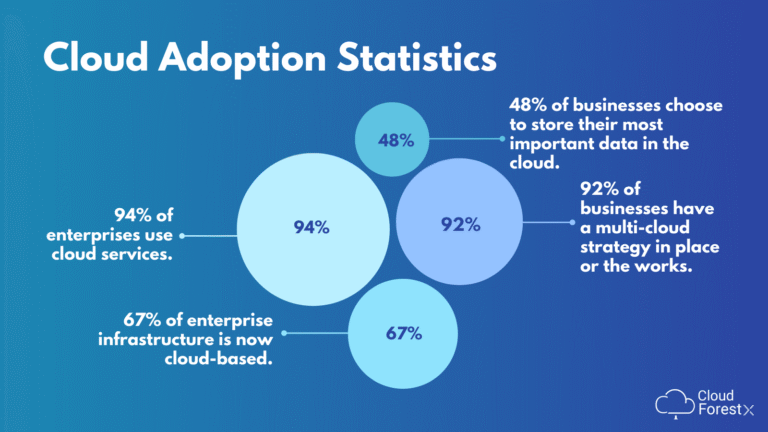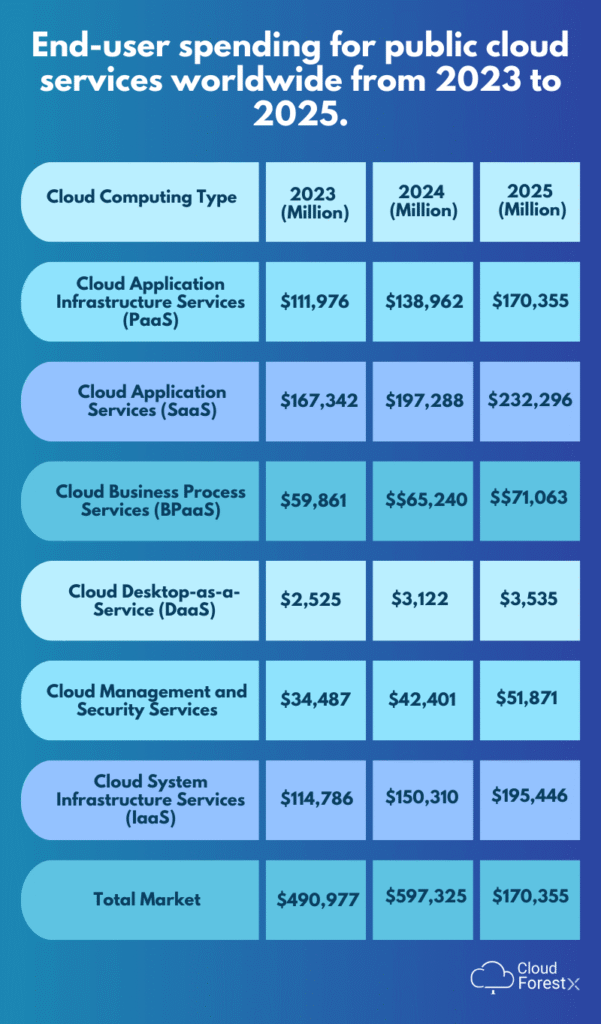Migrating to the Cloud: Best Practices and Common Pitfalls
Migrating to the cloud can be a daunting task. Still, with proper planning and execution, it can also bring many benefits to your organization, such as increased scalability, flexibility, and cost savings.
This blog post will review some of the best practices and pitfalls to avoid when migrating to the cloud. But first, let’s have a quick overview of what is cloud migration.

Cloud Adoption Statistics
- 94% of enterprises use cloud services.
- 67% of enterprise infrastructure is now cloud-based.
- 92% of businesses have a multi-cloud strategy in place or the works.
- 48% of businesses choose to store their most important data in the cloud
What is Cloud Migration? An Overview
Cloud migration moves applications, data, infrastructure, security, and other resources to a cloud computing environment. Typically, enterprises move data, applications, and IT services from on-premise servers to public clouds, but cloud migration also includes moving data and applications from one cloud provider to another.
Once migrated, the systems can remain as is or go through ongoing optimization and modernization. Cloud migration can also be done in the background from the cloud provider back to the internal server.
The table below shows the projected end-user spending for public cloud services worldwide from 2023 to 2025.

Best Practices to Consider for Cloud Migration
Businesses across all industries are accelerating digital transformation initiatives, where the cloud is critical. On-demand self-service environments provide a reason for cloud migration, as cloud architectures help businesses reinvent and address uncertainties. Not only this but there are several reasons for migrating to the cloud. However, it is critical to implement proper practices for cloud migration to avoid risks or vulnerabilities.
Below are a few best practices when migrating to a cloud platform.
1. Understand your business needs and goals.
Before moving to the cloud, it’s essential to understand your business needs and objectives clearly. This will help guide your decision-making process and ensure you choose the right cloud provider and service for your organization. Look at your current situation, determine your goals, and how the cloud will help you.
2. Let's start small
A good practice is starting with small, non-essential tasks and gradually moving to more complex and business-critical tasks. This will give you experience and confidence in successfully migrating to the cloud. It also allows you to experiment with different migration methods and equipment and identify potential issues before migrating your mission-critical applications.
3. Conduct the testing
Always use a proper test staging environment before migrating your applications to verify the success of the migration process and guarantee that your applications will perform as expected. This will identify and prevent any compatibility issues and monitor them to recognize that your applications can handle the load of a cloud environment.
4. Cloud-native service delivery
Take advantage of your cloud provider’s cloud-native services and tools, such as databases, storage, and analytics. These services can often be more cost-effective and scalable than managing an on-site solution and can help reduce the complexity of your migration. Using cloud-native services and tools will help you take advantage of the unique benefits offered by cloud providers, such as elasticity, scalability, and automation, which can help improve your overall efficiency and reduce costs.
5. Create a comprehensive migration plan
Creating a comprehensive migration plan is critical to the success of your migration project. The plan should include scheduling, resource delivery, testing and certification, communication, and training. The timeline should be clear, measurable, achievable, and communicated to all stakeholders. You must allocate resources and assign responsibilities to ensure the migration is completed on time and within budget.
6. Hire an expert
If you need in-house expertise, hiring a cloud migration specialist or using the professional services of a cloud provider can be beneficial. They can help you design and implement your migration plan, follow best practices, and avoid common pitfalls. They can provide guidance and support throughout the migration process and help you optimize your resources and costs in the cloud.
7. Pitfalls to Avoid While Migrating to Cloud Computing Platform
- Security and compliance: Ignoring security and compliance requirements is a common pitfall. Review your security and compliance requirements early in the migration process and ensure you have the proper protocols in place to protect your data and comply with regulatory requirements. This includes things like encryption, authentication, access control, and more.
- Data loss: Data loss is another common pitfall to avoid. Before migrating to the cloud, ensure you have a robust backup and disaster recovery plan and thoroughly test your data to ensure availability. To ensure minimal data loss and maintain the integrity of your data, you should also plan for data migration, including configuration and data access testing.
- Vendor lock-in: It’s essential to consider the long-term implications of your cloud migration to avoid vendor lock-in. If you ever decide to switch to a different provider, choose a cloud provider that offers flexibility and an easy migration process. This can be done by using cloud-agnostic solutions and minimizing cloud provider-specific code, making it easier to move between providers in the future.
- Cost: One of the biggest advantages of the cloud is its pay-as-you-go price, but it’s easy to move things around and spend more than expected. Carefully manage and optimize your inventory to match your business needs and budget. This includes using stored instances, auto-scaling, and optimizing your resources.
Companies with successful cloud migration
Cloud migration has made great strides in various industries. Recognizing the potential for cost savings, improved productivity, and enhanced customer experience, industries such as finance, healthcare, retail, manufacturing, and technology have embraced the cloud to transform their operations. Here are a few notable examples include:
1. Netflix
As a first-tier entertainment service, Netflix moved its strategy to the cloud in a decade. Using Amazon Web Services (AWS), Netflix was able to grow seamlessly and go global. This migration enabled them to handle large amounts of data traffic and deliver a superior user experience to millions of customers worldwide.
2. Coca-Cola
The famous beverage company Coca-Cola embraced cloud migration to streamline its IT infrastructure and facilitate global operations. By migrating to AWS, The Coca-Cola Company achieved 40 percent operational savings and an 80 percent reduction in IT helpdesk tickets thanks to new automation.
3. General Electric (GE)
GE, a multinational company, embarked on a comprehensive cloud migration journey. With the help of Amazon Web Services (AWS), GE moved its business and applications to the cloud. This transformation has enabled GE to enhance its digital capabilities, implement advanced analytics for predictive maintenance in technology, and drive innovation across its business units.
4. Spotify
The popular music streaming service, Spotify, relies on the cloud for a vast music library and seamless consumption experience. In 2016, it implemented the Google Cloud Platform (GCP) cloud infrastructure, successfully migrating 1200 internet applications and data processing DAGs (directed acyclic graphs) from their data centers to the cloud.
5. Airbnb
As the first online marketplace for accommodation and tourism experiences, Airbnb migrated to the cloud platform to support its rapid growth and global expansion. Working with Amazon Web Services (AWS), Airbnb gained the scalability necessary to meet the growing demand for its platform and enabled consistent reliability for hosts and guests. It also checked the experience.
Cost Savings and ROI of cloud computing
One of the main drivers of cloud migration is the potential for cost savings. By transitioning from on-premise infrastructure to the cloud, businesses can significantly reduce the capital costs associated with physical hardware purchases and maintenance. Instead, they can implement a pay-as-you-go model through resources and pay for services.
This shift to operational expenditure (OpEx) enables organizations to align their IT spending with actual usage, eliminating the need for over-provisioning and reducing overall infrastructure spend. Automated systems for optimizing cloud spend deliver the benefits of saving time and reducing unnecessary costs.
According to the Flexera 2022 State of the Cloud Report, more than 40% of enterprises use automated systems to monitor their environments, prevent downtime, and continuously limit waste. Recent studies suggest many other benefits, e.g.:
1. Companies using cloud computing save 20% annually on infrastructure costs:
By leveraging the power of the cloud, organizations can dramatically reduce the cost of their services, thereby providing valuable resources to other strategic areas of their business independence. This data is a compelling example of how cloud computing enables businesses to save money and increase operational efficiency.
2. 25% of IT budgets will be allocated to cloud-based services in 2021:
Growing industry recognition of the potential cost savings offered by cloud-based services is an important statistic to consider when considering cloud cost savings. This confirms that businesses are actively embracing cloud technology and willingly investing in cloud-based services to unlock its benefits. These figures highlight how companies are harnessing and reaping the benefits of cloud computing.
3. 84% of businesses that adopt cloud reduced computing costs:
The shift to the cloud provides significant business cost savings and highlights essential aspects in a blog post focusing on cloud cost savings calculations. These cost reductions show the benefits that cloud computing offers and a strong incentive for readers to consider migrating their businesses to the cloud.
Conclusion
Migrating to the cloud can be a challenging process, but with proper planning and execution, it can bring many benefits to your organization. Take the time to understand your business needs, test and stage your move, and have a robust backup and disaster recovery plan to avoid common pitfalls.
Place the right practices in place and prepare yourself so you can successfully migrate to the cloud and reap all its benefits. Remember that migrating to the cloud is an ongoing process and requires constant review and updates to ensure your environment is aligned with your business needs and goals. Additionally, stay up-to-date with the latest trends and advancements in cloud technology to take advantage of new features and capabilities as they become available.
Frequently Asked Questions (FAQs)
How big is the Cloud Migration Market?
The cloud migration market is set to see significant growth. In 2023, it is expected to be worth $181.31 billion. The market is expected to expand at a compound annual growth rate (CAGR) of 28.24%, reaching a staggering USD 628.83 billion by 2028. This growth indicates the adoption of cloud migration solutions has increased in various sectors.
Who are the key players in the Cloud Migration Market?
Key players in the cloud migration market include Accenture PLC, IBM Corporation, Amazon Web Services Inc., Cisco Systems Inc., and Microsoft Corporation. These companies play a crucial role in providing sophisticated cloud migration solutions and services, contributing significantly to the growth and development of the market.
Which is the fastest-growing cloud migration market?
The Asia-Pacific region has been identified as the fastest-growing market for cloud migration. It is expected to witness the highest annual growth rate (CAGR) during the forecast period from 2023 to 2028. This increasing growth indicates an increasing adoption of cloud technologies and migration services in the Asia Pacific region.
Which region has the largest share in the cloud migration market?
North America currently holds the largest share of the cloud migration market. The companies’ dominance is driven by the early and widespread adoption of cloud technologies, the presence of key industry players, technological advancements, and robust cloud infrastructure
What is driving market growth for cloud migration?
The cloud mobility market is growing due to the flexibility of IT infrastructure, cost-effective solutions, and increasing awareness of the benefits of cloud migration. The continued development of cloud technologies, especially hybrid and multi-cloud options, . Varies according to specific business needs. Moreover, it accelerates the market growth by providing various deployment options.
